‘They Dream Only of’ the Lilac Cube
Tucked away under a bridge on the east side of Leamington Spa lies both South Bound Café and Windmill Brewery. Home to fine distilleries, select jazz music and, most importantly, on a very special evening every term or so, a selection of poets brought to you by the Lilac Cube. Launched in November 2024, Lilac Cube, named after John Ashbery’s poem ‘They Dream Only of America,’ is a series of contemporary poetry readings. Ashbery’s experimental poem crafts a dissociative and awakening experience, fusing dream and reality, an experience that is replicated with the events of the Lilac Cube. Founder of Lilac Cube, Dr Mae Losasso, states that she intended for the Lilac Cube ‘to feel like social events at which poems are read, not the other way around.’ The poetry readings feel like something you can step in and out of, like a “dream”, to sort of alter or escape “reality.” The Lilac Cube fosters an environment where people can discuss their love for the arts with fellow poetry-enjoyers and the wonderful poets themselves. So far, there have been three installments of the Lilac Cube where several poets have graced audiences with their poetic performances. These include Jonathan Skinner, Betsy Porritt, Sam Weselowski, CA Conrad, Holly Pester, Isabel Galleymore, Stephen Collis, Annie Lafleur and Steven Seidenburg. Entry is free, all are welcome. It is a chance to talk to artists, purchase their work, get it signed, ask them questions and become enlightened by their responses. Most importantly, it champions the fact that poetry should always be spoken and received aloud, with a certain kind of reverence.
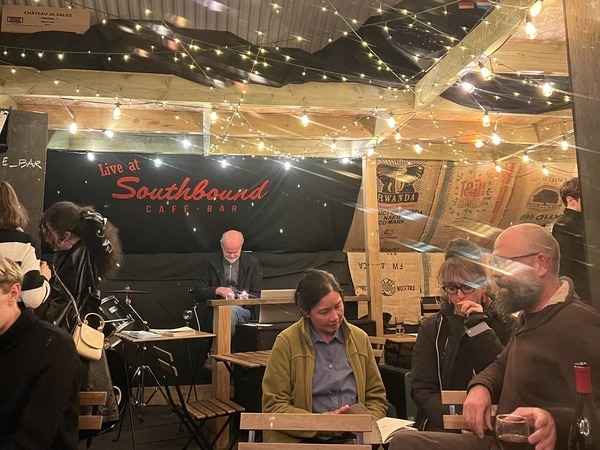
Lilac Cube #1: SOUND:
Sound poetry is a literary style that privileges the phonetic aspects of human (and non-human) speech over conventional semantic methods. It is concerned with how words are wielded to create sound. At the first installment of the Lilac Cube, the room was flooded with ambient jazz, excited chatter and the rumble of trains passing overhead. Two champions of sound poetry greeted us at the debut of Lilac Cube: Dr Jonathan Skinner and Dr Betsy Porritt. Skinner is currently a faculty member of both English and Comparative Literary Studies and the Writing Program at the University of Warwick. His main interests are ecopoetics, placing emphasis on the connections between the human and the non-human environment. His acclaimed journal, Ecopoetics, publishes writing that explores the critical links between literature and ecology. From his work surrounding ecopoetics, Skinner has published five poetry collections, his most recent works being The Archive, published 2024. Reading from his 2024 collection, Skinner impressed upon the audience one of the primary focuses of ecopoetics – the study of sound. His reading of ‘TRANSCRIPTION’ was accompanied by a recording of a Nightingale’s call, allowing his audience to fully immerse themselves into the interconnectedness between poetry and ecology. One of our favourite selection of lines in the poem is as follows:
Poets…………………………………………………………………..remain hunkered in the
crooks of the trees………….from which they sing (Skinner, l.?)
The long sequences of full stops indicate the places in which Skinner stopped reading the words of the poem and let the room be consumed only by the recording of birdsong. The long pause flooded with bird calls after the word ‘Poets’, served a double purpose. Firstly, it set up the very meaning of the line by allowing the Nightingale or the beings that reside in ‘the crooks of the trees’ to be the literal example of the ‘Poets’ that Skinner depicts. Secondly, it drew attention to the purpose of the evening: for poetry to be read and enjoyed aloud. Both the speakers, the audience and the call of the nightingale work together to illustrate the intersections between poetry and ecology.
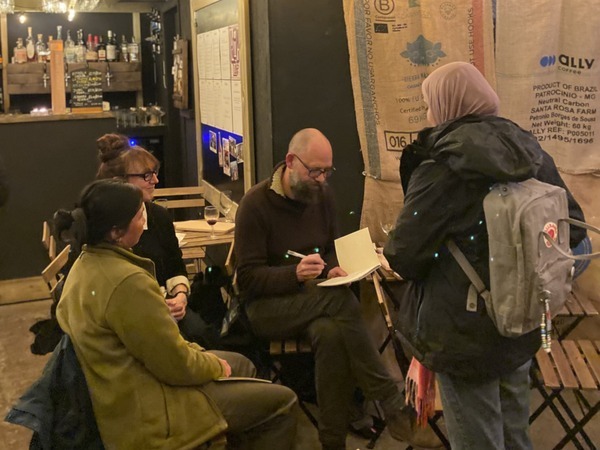
Being committed to a discursive and engaging poetry space, the second reader of the night was the interdisciplinary humanities scholar, Dr Betsy Porritt. As a member of the University of Birmingham’s Liberal Arts department, both her academic work and poetry collections are rooted in an interest in investigative poetry. Following on from Skinners’ reading, built on radical syntactic construction, Porritt explores the possibilities of ‘sound to register.’ Use of grammar, words and expressions are selected to privilege the encounter of sound for the audience. Porritt has published two poetry chapbooks, small printed collections of work traditionally containing popular literature such as ballads, folklore or poetry. Bound using simpler methods than full length books and typically up to 40 pages long, the publication becomes a focused collection of work. A modern chapbook has become recognised as a medium for alternative and emerging writers and publishers. This alternative style is duly expressed in her poem ‘Experiments’ from her collection Oh Unquenchable Thirst (Distance No Object, 2024). As the final reading of the night, the poem, which required the entire audience to sustain a continuous humming throughout, poses us the question, how much of poetry is pure sound?
In the physical space of the cafe the sound becomes contained and bounces back, from echoes off the walls, to the sound of transport overhead, to the select periods of intermission between poets where laughter and discussion is cultivated
The poem is 6 short stanzas in length and consists of the refrain “I took my shoes off”. Through Porritts’ manipulation of the human breath, the immediate challenge becomes the task of continuing to extend our breath for the poem’s benefit. The poem’s lack of punctuation and sprawling settings: “margate sands…Turin…farmyard in Devon…Wales…England…London Road…Dover…Spain…Midland Oak…suburb of a seaside town”, contend with a pervading sense of radical intimacy; being both in the presence of the speaker taking their shoes off as a key motif, as well as the shared breath that is propelling the very poem forward, contributed from the audience. In the physical space of the cafe the sound becomes contained and bounces back, from echoes off the walls, to the sound of transport overhead, to the select periods of intermission between poets where laughter and discussion is cultivated. Experiments tests our ability to focus on the minute and essentials details, in the content of the poem, whilst simultaneously having the audience work as an artistic collective in its form.
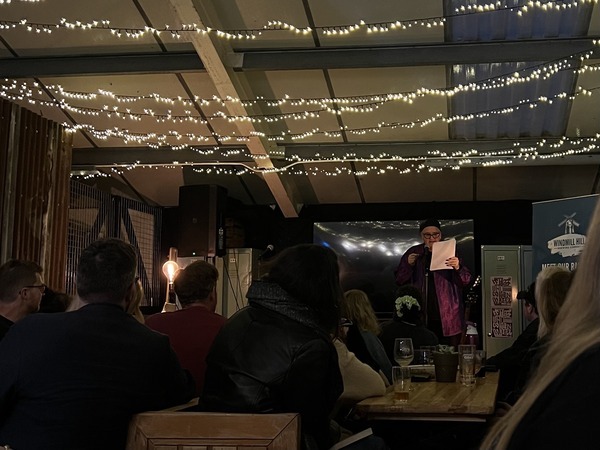
Lilac Cube #2: SOMATIC
The second installment of the Lilac Cube was held in the Windmill Brewery, still partnered with the overhead railroad noise and the recent additions of the thrumming machinery and whirring beer. Strings of fairy lights crowned the room, filled with the same feverish babble, drinks in hand and a single microphone awaiting the forthcoming poets.
In the words of Ocean Vuong, ‘one of America’s most legendary living poets,’ CAConrad, was rewardingly featured in night two of the Lilac Cube. Since 1975, CAConrad has worked with the ancient technologies and rituals of poetry. In particular, CAConrad focuses on somatic ritual, meaning that which regards the entity of the body, especially in distinction from the mind.
They have authored numerous collections of poetry, including The Book of Frank (2010), Amanda Paradise: Resurrect Extinct Vibration (2021) and You Don’t Have What It Takes to Be My Nemesis: And Other (Soma)tics (2023). Their most recent collection, Listen to the Golden Boomerang Return (2024), was the feature of their performance in Lilac Cube #2. The collection holds seventy-two poems in total, all ‘breathing wild creatures’ waiting to be read aloud. In an interview for the Louisiana Channel, entitled “Poetry as a Performance”, CAConrad discussed the importance of reading poetry aloud, stating that in doing so the audience is able to ‘hear the way [they] present and how [they] feel the poem.’ Through them, the purpose of art is put into action: ‘to change somebody’s perspective.’ CAConrad’s sentiments in this interview were not lost in their performance in Lilac Cube #2.
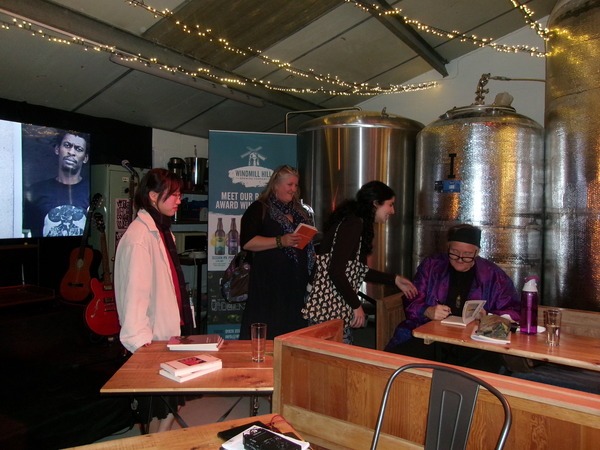
CAConrad read several poems from their latest collection, stopping at certain points to interject humorous yet enlightening anecdotes that informed their artistry. These ranged from tales of their youth, sleeping with men in churches, meeting one of the eldest chickens in the world and responding to hateful emails from bitter straight men with “Thank you Daddy.” Keeping the audience enraptured with an amused storytelling that painted the electric backdrop for the bizarre yet touching poetry being read aloud.
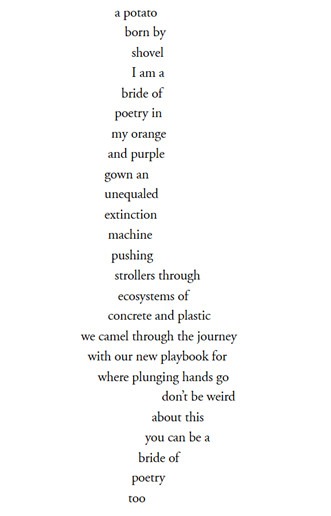
Listen to the Golden Boomerang Return is a practice in urgent, angry and joyful writing, one that privileges the body as a receptacle of poetry. From ecological references detailing the ever present reality of climate change, “ecosystems of// concrete and plastic” to a literary-Queer resistance “the jeep that killed O’Hara”, CAConrad’s reading fitted seamlessly into the body of work presented at the Lilac Cube. One particular poem stuck with us, and felt fitting to the event and the purpose of the Lilac Cube. In it, CAConrad declares themself as a ‘bride of poetry’. CAConrad suggests that this life is a ‘journey’ and in it, poetry becomes a source of guidance, of enlightenment. Our ‘plunging hands’ feels visceral, linking back to the poet’s expressed interest in somatic ritual. The hands, being a part of our body, become a symbol for how our body is distinct from our mind. They cannot help but ‘plunge’. However, the practice of poetry, of creating art, becomes our ‘playbook’ in navigating this ‘journey’ that we call life. CAConrad concludes the poem by holding the hand of the audience and telling us that we too, can be brides of poetry. We too, can use poetry as a form of wayfinding.
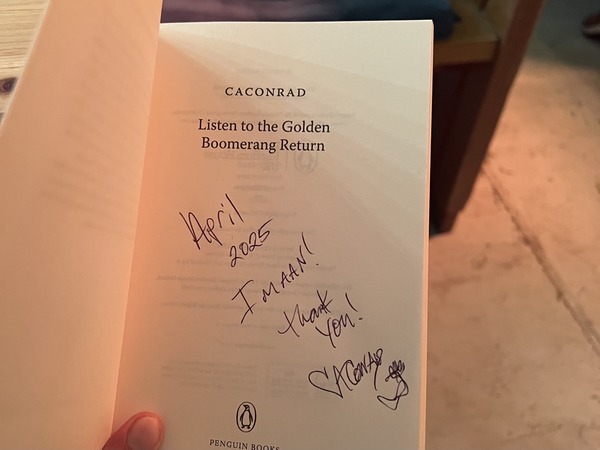
Lilac Cube: An Interview with the Curator
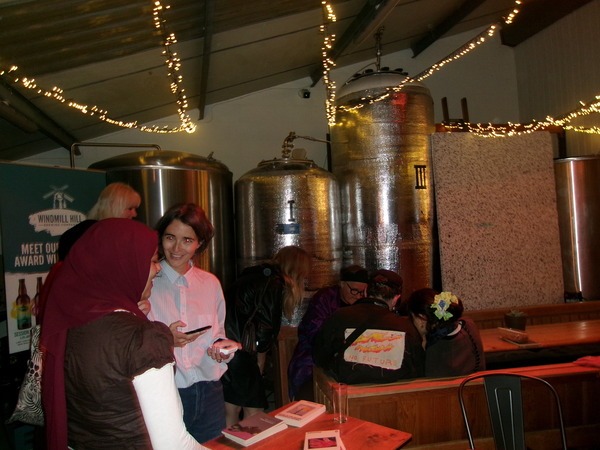
Founder of the Lilac Cube, Dr Mae Losasso agreed to speak with us regarding the creation of Lilac Cube. Dr Mae Losasso teaches in the Department of English and Comparative Literary studies at the University of Warwick. She specialises in poetry, particularly Breath Poetics and The New York School poets. In her first book, Poetry, Architecture and the New York School, she examines the relationship between poetics and architecture in the work of the first generation New York School poets, Frank O’Hara, John Ashbery, Barbara Guest, and James Schuyler. Her current research project, entitled Breathturn, examines the poetry of a number of post-45 American, Canadian, and British poets, mapping the preoccupation of breath and breathlessness through close readings. Here, she discusses her inspirations, intent and aspirations for the Lilac Cube.
- What inspired the creation of the Lilac Cube? Did you feel as if there was something missing from the creative field that the Lilac Cube fulfils?
I came to work at Warwick because of the University’s reputation for poetry – there’s a strong tradition of world-leading scholars teaching and publishing on poetics in the department of English and Comparative Literary Studies. Thanks to the pandemic, however, there was very little in the way of what you might call a ‘poetry scene’ when I arrived in 2023. Cuts to funding had also made it difficult to establish a regular series. This was something I urgently wanted to address. As a scholar who works on modern and contemporary poetics, I firmly believe that poetry needs spaces in which to thrive beyond the classroom. Talking critically about poems in a seminar setting comprises a vital element of a literature degree; but hearing poets read their work is also essential to an appreciation – and enjoyment – of the form.
I don’t think poetry readings should be too stiff or sacrosanct; they need to be lively, maybe even a little rowdy, which is why Lilac Cube takes place in a bar
I’ve been very lucky to have had the support of the poet and scholar Jonathan Skinner in running this series. Jonathan is also an advocate for public poetry readings and knows an awful lot of poets on both sides of the Atlantic. It’s been a lot of fun inviting poets we both know – and hopefully that sense of sociality has rubbed off on the audience a bit at each event. I don’t think poetry readings should be too stiff or sacrosanct; they need to be lively, maybe even a little rowdy, which is why Lilac Cube takes place in a bar. I want them to feel like social events at which poems are read, not the other way around.
- In the first show, the performances featured local creatives (such as Betsy Porritt) and members of Warwick faculty (Jonathan Skinner and Sam Weselowski). How important is the local sphere to creative events such as this? Was one of the aims of these events to spotlight local voices?
It was always essential to me that these events be held off-campus. In part, this is so that students have the opportunity to experience contemporary poetry outside the classroom, but also to take poetry beyond the academy. I wanted to think about how the university could run a series that might lead to local community impact and cultural enrichment. As such, Lilac Cube is a freely accessible and widely inclusive space where people can hear well-known poets, as well as a platform for local and University-based poets to read their work – and I’m especially keen for established and up-and-coming voices to share a stage. Poetry isn’t the preserve of the academy. It’s also not a lucrative vocation – it often relies on community and on the sharing of work, which is why series’ like Lilac Cube are essential for keeping poetry in circulation.
I’ve also been fortunate to have the support of local venues, Southbound Café and Windmill Hill Brewery, both of which have been enthusiastic about the possibility of a regular poetry series. One is a wine bar, the other a microbrewery (and both of them are under railway arches, so poets have to compete with the grumble of trains overhead). These small, industrial spaces lend themselves to the kind of poetry night I’ve always had in mind (intimate, convivial, a bit DIY, a bit boisterous), and it’s been great to develop mutually sustaining collaborations with local venues.
- You have dedicated your academia to the study of poetry, and we recognise a greater commitment to this artistic medium in these Lilac Cube events. In times where the arts are being devalued, how do these events shed light on the typical nonchalance towards poetry?
Amid a widespread and concerted effort to devalue the arts, there is often a sense that literature – and perhaps especially poetry – doesn’t matter. This simply isn’t true; literature matters more in periods of crisis than at any other time. In her recent book Radical Tenderness, the poet and critic Andrea Brady puts this better than I can. “I wouldn’t say that poetry is more effective than being in the streets”, Brady writes. But: “when it’s easier to imagine the end of the world than the end of capitalism, there are many poets working hard to imagine the way this form of the world might end. They are doing it together, at poetry readings and performances, in magazines and small presses, in conversation, sustaining each other and hope.”
Poetry creates communities – it always has done – and one of the ways it does this is through gatherings and readings. It doesn’t – and shouldn’t – replace collective action, but it does open a tangible space in which to imagine together, and in which to sustain each other, in increasingly bleak (not to mention increasingly virtual) times. Poetry readings are also fun.
- What does the future hold for the Lilac Cube? Where do you hope to see it go?
I’m keen to develop a wider cultural scene through Lilac Cube, exploring routes of collaboration with local arts institutions and universities. There are tentative plans afoot for a summer poetry festival in 2026, perhaps teaming up with the University of Birmingham. From its inception Lilac Cube has worked closely with the London-based graphic designer Seán Purdy, who creates all of the brilliant event posters. Seán and I are interested in the visual directions that Lilac Cube might take (the name for the series, by the way, comes from a poem by John Ashbery; but the White Cube gallery association isn’t accidental), perhaps by bringing poetry and visual art together, or by developing a beautifully-designed small press through which to publish contemporary poetry. For now though, you can expect more Leamington events in the autumn. Stay tuned on the Lilac Cube web page or on Instagram @lilac.cube.
End of Interview
We encourage everyone to attend, it is a rewarding opportunity to be able to witness a curation of artists share their art, their muses and their intellect
The call of a nightingale, the beckon of sound poetry, the mumbling of jazz, the ambience of fairy lights, an anecdote about a chicken and the separation of body from the mind have all been found at the events hosted by Lilac Cube. They are memorable nights and are open to all who want to immerse themselves into the performance of poetry, (and most importantly to get a signed edition or two!) We encourage everyone to attend, it is a rewarding opportunity to be able to witness a curation of artists share their art, their muses and their intellect.
And hiding from darkness in barns
They can be grownups now
And the murderer’s ashtray is more easily—
The lake a lilac cube. (Ashbery, 1973)
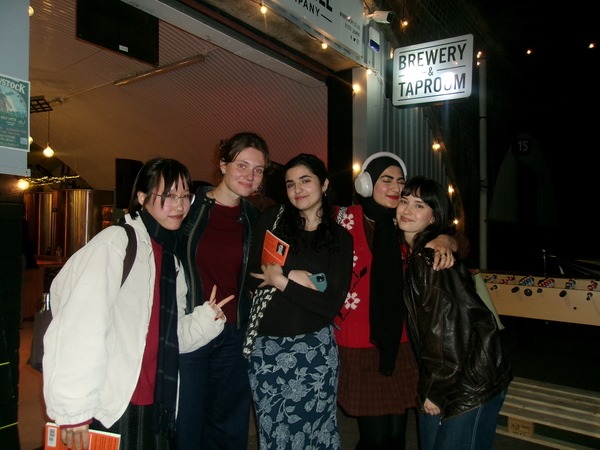
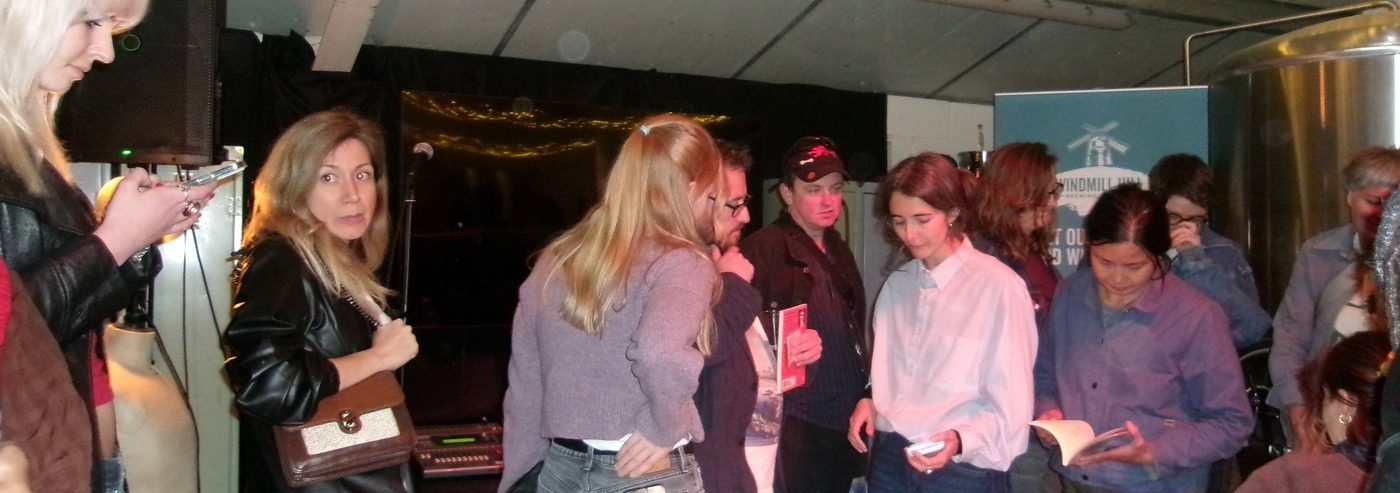
Comments (2)
such a beautifully written piece :>
ts is fire